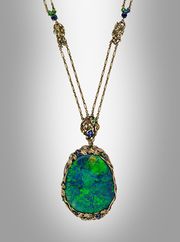Difference between revisions of "Black opal"
Jump to navigation
Jump to search
(username removed) |
|||
| (3 intermediate revisions by 2 users not shown) | |||
| Line 1: | Line 1: | ||
| + | [[File:Tiffany necklacee-SC360924.jpg|thumb|Tiffany necklace<br>MFA# 2017.1328]] | ||
== Description == | == Description == | ||
| − | An [ | + | An [[opal|opal]] with vivid iridescent colors on a dark background. Black opals were first discovered in 1902 at Lightning Ridge in New South Wales, Australia. Black opals display different color patterns depending on the viewing angle. The colors depend on the crystal size within the stone. When the particles are small, some purple can be seen. Medium sized particles diffract green and larger particles show red. |
== Synonyms and Related Terms == | == Synonyms and Related Terms == | ||
| Line 7: | Line 8: | ||
ópalo negro (Esp.); opala negra (Port.) | ópalo negro (Esp.); opala negra (Port.) | ||
| − | == | + | == Risks == |
| − | + | * Chronic inhalation may cause lung damage | |
| + | * Dehydration may cause surface cracking | ||
| + | == Physical and Chemical Properties == | ||
| − | Iridescent. Fluoresce=usually white or pale green, some samples phosphoresce | + | * Massive with no crystalline structure. |
| + | * Cleavage=none | ||
| + | * Luster = vitreous to pearly. | ||
| + | * Fracture = conchoidal. | ||
| + | * Streak = white | ||
| + | * Iridescent. | ||
| + | * Fluoresce=usually white or pale green, some samples phosphoresce | ||
{| class="wikitable" | {| class="wikitable" | ||
| Line 19: | Line 28: | ||
|- | |- | ||
! scope="row"| Density | ! scope="row"| Density | ||
| − | | 1.98-2.25 | + | | 1.98-2.25 g/ml |
|- | |- | ||
! scope="row"| Refractive Index | ! scope="row"| Refractive Index | ||
| Line 25: | Line 34: | ||
|} | |} | ||
| − | == | + | ==Resources and Citations== |
| − | + | * Mineralogy Database: [http://www.webmineral.com/data/Opal.shtml Opal] | |
| − | + | * Wikipedia: http://en.wikipedia.org/wiki/Opal (accessed Oct. 12, 2005) | |
| − | |||
| − | |||
| − | |||
| − | |||
| − | |||
| − | |||
| − | |||
| − | * Wikipedia | ||
* Yasukazu Suwa, ''Gemstones: Quality and Value, Volume 1'', Sekai Bunka Publishing Inc., Tokyo, 1999 | * Yasukazu Suwa, ''Gemstones: Quality and Value, Volume 1'', Sekai Bunka Publishing Inc., Tokyo, 1999 | ||
Latest revision as of 07:46, 8 May 2022
Description
An Opal with vivid iridescent colors on a dark background. Black opals were first discovered in 1902 at Lightning Ridge in New South Wales, Australia. Black opals display different color patterns depending on the viewing angle. The colors depend on the crystal size within the stone. When the particles are small, some purple can be seen. Medium sized particles diffract green and larger particles show red.
Synonyms and Related Terms
ópalo negro (Esp.); opala negra (Port.)
Risks
- Chronic inhalation may cause lung damage
- Dehydration may cause surface cracking
Physical and Chemical Properties
- Massive with no crystalline structure.
- Cleavage=none
- Luster = vitreous to pearly.
- Fracture = conchoidal.
- Streak = white
- Iridescent.
- Fluoresce=usually white or pale green, some samples phosphoresce
| Mohs Hardness | 5.5 - 6.5 |
|---|---|
| Density | 1.98-2.25 g/ml |
| Refractive Index | 1.42-1.47 |
Resources and Citations
- Mineralogy Database: Opal
- Wikipedia: http://en.wikipedia.org/wiki/Opal (accessed Oct. 12, 2005)
- Yasukazu Suwa, Gemstones: Quality and Value, Volume 1, Sekai Bunka Publishing Inc., Tokyo, 1999
- Michael O'Donoghue and Louise Joyner, Identification of Gemstones, Butterworth-Heinemann, Oxford, 2003
